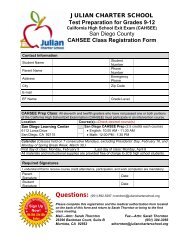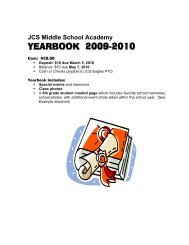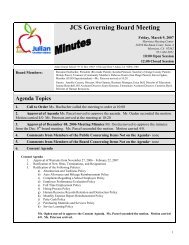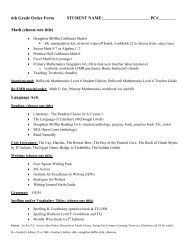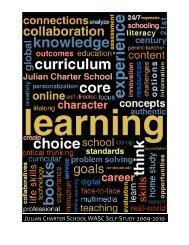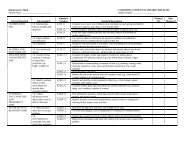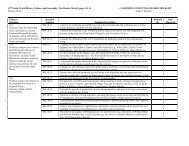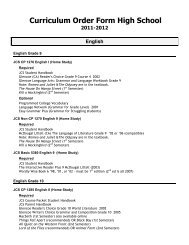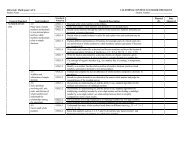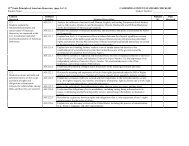8th Grade: English-Language Arts (page 1 of 3) - Julian Charter ...
8th Grade: English-Language Arts (page 1 of 3) - Julian Charter ...
8th Grade: English-Language Arts (page 1 of 3) - Julian Charter ...
Create successful ePaper yourself
Turn your PDF publications into a flip-book with our unique Google optimized e-Paper software.
<strong>8th</strong> <strong>Grade</strong>: <strong>English</strong>-<strong>Language</strong> <strong>Arts</strong> (<strong>page</strong> 1 <strong>of</strong> 3)<br />
CALIFORNIA CONTENT-STANDARD CHECKLIST<br />
Student Name: ____________________ Student Number: ____________________<br />
General<br />
Standard<br />
READING<br />
(“R”)<br />
Sub-Standard<br />
1.0<br />
Word Analysis,<br />
Fluency, and<br />
Systematic<br />
Vocabulary<br />
Development<br />
2.0<br />
Reading<br />
Comprehension<br />
(read one million<br />
words annually)<br />
3.0<br />
Literary<br />
Response and<br />
Analysis<br />
Standard<br />
Notation<br />
8.R.1.1<br />
8.R.1.2<br />
8.R.1.3<br />
8.R.2.1<br />
8.R.2.2<br />
8.R.2.3<br />
8.R.2.4<br />
8.R.2.5<br />
8.R.2.6<br />
8.R.2.7<br />
8.R.3.1<br />
8.R.3.2<br />
8.R.3.3<br />
8.R.3.4<br />
8.R.3.5<br />
8.R.3.6<br />
8.R.3.7<br />
Standard Description<br />
Analyze idioms, analogies, metaphors, and similes to infer the literal and figurative<br />
meanings <strong>of</strong> phrases.<br />
Understand the most important points in the history <strong>of</strong> <strong>English</strong> language and use<br />
common word origins to determine the historical influences on <strong>English</strong> word<br />
meanings.<br />
Use word meanings within the appropriate context and show ability to verify those<br />
meanings by definition, restatement, example, comparison, or contrast.<br />
Compare and contrast the features and elements <strong>of</strong> consumer materials to gain<br />
meaning from documents (e.g., warranties, contracts, product information,<br />
instruction manuals).<br />
Analyze text that uses proposition and support patterns.<br />
Find similarities & differences between texts in the treatment, scope, or organization<br />
<strong>of</strong> ideas.<br />
Compare the original text to a summary to determine whether the summary<br />
accurately captures the main ideas, includes critical details, and conveys the<br />
underlying meaning.<br />
Understand and explain the use <strong>of</strong> a complex mechanical device by following<br />
technical directions.<br />
Use information from a variety <strong>of</strong> consumer, workplace, and public documents to<br />
explain a situation or decision and to solve a problem.<br />
Evaluate the unity, coherence, logic, internal consistency, and structural patterns <strong>of</strong><br />
text.<br />
Determine and articulate the relationship between the purposes and characteristics <strong>of</strong><br />
different forms <strong>of</strong> poetry (e.g., ballad, lyric, couplet, epic, elegy, ode, sonnet).<br />
Evaluate the structural elements <strong>of</strong> the plot (e.g., subplots, parallel episodes, climax),<br />
the plot’s development, and the way in which conflicts are (or are not) addressed and<br />
resolved.<br />
Compare and contrast motivations and reactions <strong>of</strong> literary characters from different<br />
historical eras confronting similar situations or conflicts.<br />
Analyze the relevance <strong>of</strong> the setting (e.g., place, time, customs) to the mood, tone, and<br />
meaning <strong>of</strong> the text.<br />
Identify and analyze recurring themes (e.g., good versus evil) across traditional and<br />
contemporary works.<br />
Identify significant literary devices (e.g., metaphor, symbolism, dialect, irony) that<br />
define a writer’s style and use those elements to interpret the work.<br />
Analyze a work <strong>of</strong> literature, showing how it reflects the heritage, traditions,<br />
attitudes, and beliefs <strong>of</strong> its author. (Biographical approach)<br />
Planned<br />
(X)<br />
Date<br />
Mastered
WRITING<br />
(W)<br />
1.0<br />
Writing<br />
Strategies<br />
8.W.1.1<br />
8.W.1.2<br />
8.W.1.3<br />
8.W.1.4<br />
8.W.1.5<br />
8.W.1.6<br />
Create compositions that establish a controlling impression, have a coherent thesis,<br />
and end with a clear and well-supported conclusion.<br />
Establish coherence within and among paragraphs through effective transitions,<br />
parallel structures, and similar writing techniques.<br />
Support theses or conclusions with analogies, paraphrases, quotations, opinions from<br />
authorities, comparisons, and similar devices.<br />
Plan and conduct multiple-step information searches by using computer networks &<br />
modems.<br />
Achieve an effective balance between researched information and original ideas.<br />
Revise writing for word choice; appropriate organization; consistent point <strong>of</strong> view;<br />
and transitions between paragraphs, passages, and ideas.
<strong>8th</strong> <strong>Grade</strong>: <strong>English</strong>-<strong>Language</strong> <strong>Arts</strong> (<strong>page</strong> 2 <strong>of</strong> 3)<br />
CALIFORNIA CONTENT-STANDARD CHECKLIST<br />
Student Name: ____________________ Student Number: ____________________<br />
General<br />
Standard<br />
WRITING<br />
(W)<br />
(continued)<br />
Sub-Standard<br />
2.0 Writing<br />
Applications<br />
(Genres & Their<br />
Characteristics)<br />
Write narrative,<br />
expository,<br />
persuasive, &<br />
descriptive texts<br />
<strong>of</strong> at least 500 to<br />
700 words in<br />
each genre.<br />
Standard<br />
Notation<br />
8.W.2.1<br />
a, b, c<br />
8.W.2.2<br />
a, b, c, d<br />
8.W.2.3<br />
a, b, c, d<br />
8.W.2.4<br />
a, b, c<br />
8.W.2.5<br />
a, b<br />
8.W.2.6<br />
a, b, c<br />
Standard Description<br />
Write biographies, autobiographies, short stories, or narratives:<br />
a. Relate a clear, coherent incident, event, or situation by using well-chosen details.<br />
b. Reveal the significance <strong>of</strong>, or the writer’s attitude about, the subject.<br />
c. Employ narrative and descriptive strategies (e.g., relevant dialogue, specific action,<br />
physical description, background description, comparison or contrast <strong>of</strong> characters).<br />
Write responses to literature:<br />
a. Exhibit careful reading and insight in their interpretations.<br />
b. Connect student’s own responses to the writer’s techniques & to specific textual<br />
references.<br />
c. Draw supported inferences about the effects <strong>of</strong> a literary work on its audience.<br />
d. Support judgments through references to text, other works, authors, or personal<br />
knowledge.<br />
Write research reports:<br />
a. Define a thesis.<br />
b. Record important ideas, concepts, and direct quotations from significant information<br />
sources and paraphrase and summarize all perspectives on the topic, as appropriate.<br />
c. Use a variety <strong>of</strong> primary and secondary sources and distinguish the nature and value<br />
<strong>of</strong> each.<br />
d. Organize and display information on charts, maps, and graphs.<br />
Write persuasive compositions:<br />
a. Include a well-defined thesis (i.e., one that makes a clear and knowledgeable<br />
judgment).<br />
b. Present detailed evidence, examples, and reasoning to support arguments,<br />
differentiating between facts and opinion.<br />
c. Provide details, reasons, and examples, arranging them effectively by anticipating<br />
and answering reader concerns and counterarguments.<br />
Write documents related to career development, including simple business letters and<br />
job<br />
applications:<br />
a. Present information purposefully and succinctly and meet the needs <strong>of</strong> the intended<br />
audience.<br />
b. Follow the conventional format for the type <strong>of</strong> document (e.g., letter <strong>of</strong> inquiry,<br />
memorandum).<br />
Write technical documents:<br />
a. Identify the sequence <strong>of</strong> activities needed to design a system, operate a tool, or<br />
explain the bylaws <strong>of</strong> an organization.<br />
b. Include all the factors and variables that need to be considered.<br />
c. Use formatting techniques (e.g., headings, differing fonts) to aid comprehension.<br />
Planned<br />
(X)<br />
Date<br />
Mastered
WRITTEN<br />
AND ORAL<br />
LANGUAGE<br />
(L)<br />
1.0<br />
Written and Oral<br />
<strong>Language</strong><br />
8.L.1.1<br />
8.L.1.2<br />
8.L.1.3<br />
8.L.1.4<br />
8.L.1.5<br />
8.L.1.6<br />
Use correct & varied sentence types & openings to present a lively & effective personal<br />
style.<br />
Identify and use parallelism, including similar grammatical forms, in all written<br />
discourse to present items in a series and items juxtaposed for emphasis.<br />
Use subordination, coordination, apposition, and other devices to indicate clearly the<br />
relationship between ideas<br />
Edit written manuscripts to ensure that correct grammar is used.<br />
Use correct punctuation and capitalization.<br />
Use correct spelling conventions.
<strong>8th</strong> <strong>Grade</strong>: <strong>English</strong>-<strong>Language</strong> <strong>Arts</strong> (<strong>page</strong> 3 <strong>of</strong> 3)<br />
CALIFORNIA CONTENT-STANDARD CHECKLIST<br />
Student Name: ____________________ Student Number: ____________________<br />
General<br />
Standard<br />
LISTENING<br />
& SPEAKING<br />
(LS)<br />
Sub-Standard<br />
1.0<br />
Listening and<br />
Speaking<br />
Strategies<br />
2.0<br />
Speaking<br />
Applications<br />
(Genres & Their<br />
Applications)<br />
Standard<br />
Notation<br />
8.LS.1.1<br />
8.LS.1.2<br />
8.LS.1.3<br />
8.LS.1.4<br />
8.LS.1.5<br />
8.LS.1.6<br />
8.LS.1.7<br />
a, b<br />
8.LS.1.8<br />
8.LS.1.9<br />
8.LS.2.1<br />
a, b, c<br />
8.LS.2.2<br />
a, b, c, d<br />
Standard Description<br />
Analyze oral interpretations <strong>of</strong> literature, including language choice and delivery, and<br />
the effect <strong>of</strong> the interpretations on the listener.<br />
Paraphrase a speaker’s purpose and point <strong>of</strong> view and ask relevant questions<br />
concerning the speaker’s content, delivery, and purpose.<br />
Organize information to achieve particular purposes by matching the message,<br />
vocabulary, voice modulation, expression, and tone to the audience and purpose.<br />
Prepare a speech outline based upon a chosen pattern <strong>of</strong> organization, which includes<br />
intro; transitions, previews, & summaries; logically developed body; & effective<br />
conclusion.<br />
Use precise language, action verbs, sensory details, appropriate and colorful modifiers,<br />
and the active rather than the passive voice in ways that enliven oral presentations.<br />
Use appropriate grammar, word choice, enunciation, and pace during formal<br />
presentations.<br />
Use audience feedback (e.g., verbal and nonverbal cues):<br />
a. Reconsider and modify the organizational structure or plan.<br />
b. Rearrange words and sentences to clarify the meaning.<br />
Evaluate the credibility <strong>of</strong> a speaker (e.g., hidden agendas, slanted or biased material).<br />
Interpret and evaluate the various ways in which visual image makers (e.g., graphic<br />
artists, illustrators, news photographers) communicate information and affect<br />
impressions & opinions.<br />
Deliver narrative presentations (e.g., biographical, autobiographical):<br />
a. Relate a clear, coherent incident, event, or situation by using well-chosen details.<br />
b. Reveal the significance <strong>of</strong>, and the subject’s attitude about, the incident, event, or<br />
situation.<br />
c. Employ narrative and descriptive strategies (e.g., relevant dialogue, specific action,<br />
physical description, background description, comparison or contrast <strong>of</strong> characters).<br />
Deliver oral responses to literature:<br />
a. Interpret a reading and provide insight.<br />
b. Connect students’ own responses to the writer’s techniques & to specific textual<br />
references.<br />
c. Draw supported inferences about the effects <strong>of</strong> a literary work on its audience.<br />
d. Support judgments through references to text, other works, authors, or personal<br />
knowledge.<br />
Planned<br />
(X)<br />
Date<br />
Mastered
8.LS.2.3<br />
a, b, c, d<br />
8.LS.2.4<br />
a, b, c, d<br />
8.LS.2.5<br />
<strong>8th</strong> <strong>Grade</strong>: Science: Focus on Physical Science (<strong>page</strong> 1 <strong>of</strong> 2)<br />
Student Name: ___________________________<br />
Deliver research presentations:<br />
a. Define a thesis.<br />
b. Record important ideas, concepts, and direct quotations from significant information<br />
sources and paraphrase and summarize all relevant perspectives on the topic, as<br />
appropriate.<br />
c. Use a variety <strong>of</strong> primary and secondary sources and distinguish the nature and value<br />
<strong>of</strong> each.<br />
d. Organize and record information on charts, maps, and graphs.<br />
Deliver persuasive presentations:<br />
a. Include a well-defined thesis (i.e., one that makes a clear and knowledgeable<br />
judgment).<br />
b. Differentiate fact from opinion & support args w/ detailed evidence, examples, &<br />
reasoning<br />
c. Anticipate and answer listener concerns and counterarguments effectively through<br />
the inclusion and arrangement <strong>of</strong> details, reasons, examples, and other elements.<br />
d. Maintain a reasonable tone.<br />
Recite poems (<strong>of</strong> four to six stanzas), sections <strong>of</strong> speeches, or dramatic soliloquies, using<br />
voice modulation, tone, and gestures expressively to enhance the meaning.<br />
CALIFORNIA CONTENT-STANDARD CHECKLIST<br />
Student Number: ____________________<br />
General Standard<br />
1.0<br />
MOTION<br />
The velocity <strong>of</strong> an object is the rate <strong>of</strong><br />
change <strong>of</strong> its position. As a basis for<br />
understanding<br />
2.0<br />
FORCES<br />
Unbalanced forces cause changes in<br />
velocity<br />
Standard<br />
Notation<br />
8.1.a<br />
8.1.b<br />
8.1.c<br />
8.1.d<br />
8.1.e<br />
8.1.f<br />
8.2.a<br />
8.2.b<br />
8.2.c<br />
8.2.d<br />
8.2.e<br />
8.2.f<br />
8.2.g<br />
Standard Description<br />
Position is defined in relation to some choice <strong>of</strong> a standard reference point and a set <strong>of</strong><br />
reference directions.<br />
Average speed is the total distance traveled divided by the total time elapsed and that<br />
the speed <strong>of</strong> an object along the path traveled can vary.<br />
Solve problems involving distance, time, and average speed.<br />
The velocity <strong>of</strong> an object must be described by specifying both the direction and the<br />
speed <strong>of</strong> the object.<br />
Changes in velocity may be due to changes in speed, direction, or both.<br />
Interpret graphs <strong>of</strong> position versus time and graphs <strong>of</strong> speed versus time for motion in a<br />
single direction.<br />
A force has both direction and magnitude<br />
When an object is subject to two or more forces at once, the result is the cumulative<br />
effect <strong>of</strong> all the forces.<br />
When the forces on an object are balanced, the motion <strong>of</strong> the object does not change.<br />
Identify separately the two or more forces that are acting on Ê a single static object,<br />
including gravity, elastic forces due to tension or compression in matter, and friction.<br />
When the forces on an object are unbalanced, the object will change its velocity (that is,<br />
it will speed up, slow down, or change direction).<br />
The greater the mass <strong>of</strong> an object, the more force is needed to achieve the same rate <strong>of</strong><br />
change in motion.<br />
The role <strong>of</strong> gravity in forming & maintaining the shapes <strong>of</strong> planets, stars, & the solar<br />
system<br />
Planned<br />
(X)<br />
Date<br />
Mastered
3.0<br />
STRUCTURE OF MATTER<br />
Each <strong>of</strong> the more than 100 elements <strong>of</strong><br />
matter has distinct properties and a<br />
distinct atomic structure. All forms <strong>of</strong><br />
matter are composed <strong>of</strong> one or more <strong>of</strong><br />
the elements<br />
4.0<br />
EARTH IN THE SOLAR SYSTEM<br />
(EARTH SCIENCE)<br />
The structure and composition <strong>of</strong> the<br />
universe can be learned from studying<br />
stars and galaxies and their evolution<br />
8.3.a<br />
8.3.b<br />
8.3.c<br />
8.3.d<br />
8.3.e<br />
8.3.f<br />
8.4.a<br />
8.4.b<br />
8.4.c<br />
8.4.d<br />
8.4.e<br />
The structure <strong>of</strong> the atom and know it is composed <strong>of</strong> protons, neutrons, and electrons<br />
Compounds are formed by combining two or more different elements and that<br />
compounds have properties that are different from their constituent elements.<br />
Atoms and molecules form solids by building up repeating patterns, such as the crystal<br />
structure <strong>of</strong> NaCl or long-chain polymers.<br />
The states <strong>of</strong> matter (solid, liquid, gas) depend on molecular motion<br />
In solids, atoms are closely locked in position & can only vibrate; in liquids atoms &<br />
molecules are more loosely connected & can collide with & move past one another; &<br />
in gases the atoms and molecules are free to move independently, colliding frequently<br />
Use the periodic table to identify elements in simple compounds.<br />
Galaxies are clusters <strong>of</strong> billions <strong>of</strong> stars and may have different shapes.<br />
The Sun is one <strong>of</strong> many stars in the Milky Way galaxy and that stars may differ in size,<br />
temperature, and color.<br />
Use astron. units and light yrs as measures <strong>of</strong> distances between the Sun, stars, & Earth<br />
Stars are the source <strong>of</strong> light for all bright objects in outer space and that the Moon and<br />
planets shine by reflected sunlight, not by their own light.<br />
The appearance, general composition, relative position and size, and motion <strong>of</strong> objects<br />
in the solar system, including planets, planetary satellites, comets, and asteroids.
<strong>8th</strong> <strong>Grade</strong>: Science: Focus on Physical Science (<strong>page</strong> 2 <strong>of</strong> 2)<br />
Student Name: ___________________________<br />
CALIFORNIA CONTENT-STANDARD CHECKLIST<br />
Student Number: ____________________<br />
General Standard<br />
Standard<br />
Notation<br />
Standard Description<br />
5.0<br />
8.5.a Reactant atoms and molecules interact to form products with different chemical<br />
REACTIONS<br />
properties<br />
Chemical reactions are processes in<br />
8.5.b The idea <strong>of</strong> atoms explains the conservation <strong>of</strong> matter: In chemical reactions the number<br />
which atoms are rearranged into different<br />
<strong>of</strong> atoms stays the same no matter how they are arranged, so their total mass stays the<br />
combinations <strong>of</strong> molecules<br />
same<br />
8.5.c Chemical reactions usually liberate heat or absorb heat<br />
8.5.d Physical processes include freezing and boiling, in which a material changes form with<br />
no chemical reaction.<br />
8.5.e Determine whether a solution is acidic, basic, or neutral.<br />
6.0<br />
8.6.a Carbon, because <strong>of</strong> its ability to combine in many ways with itself and other elements,<br />
CHEMISTRY IN LIVING SYSTEMS<br />
has a central role in the chemistry <strong>of</strong> living organisms.<br />
(LIFE SCIENCE)<br />
8.6.b Living organisms are made <strong>of</strong> molecules consisting largely <strong>of</strong> carbon, hydrogen,<br />
Principles <strong>of</strong> chemistry underlie the<br />
nitrogen, oxygen, phosphorus, and sulfur.<br />
functioning <strong>of</strong> biological systems 8.6.c Living organisms have many different kinds <strong>of</strong> molecules, including small ones, such as<br />
water and salt, and very large ones, such as carbohydrates, fats, proteins, and DNA.<br />
7.0<br />
8.7.a Identify regions corresponding to metals, nonmetals, and inert gases<br />
PERIODIC TABLE<br />
8.7.b Each element has a specific number <strong>of</strong> protons in the nucleus (the atomic number) &<br />
The organization <strong>of</strong> the periodic table is<br />
each isotope <strong>of</strong> element has a different but specific number <strong>of</strong> neutrons in the nucleus<br />
based on the properties <strong>of</strong> the elements 8.7.c Substances can be classified by their properties, including their melting temperature,<br />
and reflects the structure <strong>of</strong> atoms<br />
density, hardness, and thermal and electrical conductivity.<br />
8.0<br />
8.8.a Density is mass per unit volume<br />
DENSITY AND BUOYANCY<br />
8.8.b Calculate the density <strong>of</strong> substances (regular and irregular solids and liquids) from<br />
All objects experience a buoyant force<br />
measurements <strong>of</strong> mass and volume<br />
when immersed in a flu<br />
8.8.c The buoyant force on an object in a fluid is an upward force equal to the weight <strong>of</strong> the<br />
fluid the object has displaced.<br />
8.8.d Predict whether an object will float or sink<br />
9.0<br />
8.9.a Plan and conduct a scientific investigation to test a hypothesis<br />
INVESTIGATION AND<br />
8.9.b Evaluate the accuracy and reproducibility <strong>of</strong> data.<br />
EXPERIMENTATION<br />
8.9.c Distinguish between variable and controlled parameters in a test.<br />
Scientific progress is made by asking 8.9.d Recognize the slope <strong>of</strong> the linear graph as the constant in the relationship yÊ =Ê kx and<br />
meaningful questions and conducting<br />
apply this principle in interpreting graphs constructed from data<br />
careful investigations. As a basis for<br />
8.9.e Construct appropriate graphs from data and develop quantitative statements about the<br />
understanding this concept and<br />
relationships between variables.<br />
addressing the content in the other three 8.9.f Apply simple math relationships to determine a missing quantity in a math expression,<br />
strands, students should develop their<br />
given the two remaining terms (including speed = distance/Time, density =<br />
own questions and perform investigations<br />
mass/volume, force = pressure ´ area, volume = area ´height).<br />
8.9.g Distinguish between linear and nonlinear relationships on a graph <strong>of</strong> data<br />
Planned<br />
(X)<br />
Date<br />
Mastered
<strong>8th</strong> grade: United States History and Geography: Growth and Conflict (<strong>page</strong> 1 <strong>of</strong> 4)<br />
CALIFORNIA CONTENT-STANDARD CHECKLIST<br />
Student Name: ____________________ Student Number: ____________________<br />
General Standard<br />
8.1<br />
Events preceding<br />
the founding <strong>of</strong> the<br />
nation & relate<br />
their significance<br />
to development <strong>of</strong><br />
Amer. Const.<br />
Democracy<br />
8.2<br />
The political<br />
principles<br />
underlying the U.S.<br />
Constitution and<br />
compare the<br />
enumerated and<br />
implied powers <strong>of</strong><br />
the federal<br />
government<br />
8.3<br />
The foundation <strong>of</strong><br />
the American<br />
political system<br />
and the<br />
Ways in which<br />
citizens participate<br />
in it.<br />
Standard<br />
Notation<br />
Standard Description<br />
8.1.1 Describe the relationship between the moral and political ideas <strong>of</strong> the Great Awakening and the development <strong>of</strong><br />
revolutionary fervor.<br />
8.1.2 Analyze the philosophy <strong>of</strong> government expressed in the Declaration <strong>of</strong> Independence, with an emphasis on<br />
government as a means <strong>of</strong> securing individual rights (e.g., key phrases such as “all men are created equal, that<br />
they are endowed by their Creator with certain unalienable Rights”).<br />
8.1.3 Analyze how the American Revolution affected other nations, especially France<br />
8.1.4 Describe the nation’s blend <strong>of</strong> civic republicanism, classical liberal principles, and <strong>English</strong> parliamentary<br />
traditions<br />
8.2.1 Discuss the significance <strong>of</strong> the Magna Carta, the <strong>English</strong> Bill <strong>of</strong> Rights, and the Mayflower Compact<br />
8.2.2 Analyze the Articles <strong>of</strong> Confederation and the Constitution and the success <strong>of</strong> each in implementing the ideals <strong>of</strong><br />
the Declaration <strong>of</strong> Independence.<br />
8.2.3 Evaluate the major debates that occurred during the development <strong>of</strong> the Constitution and their ultimate<br />
resolutions in such areas as shared power among institutions, divided state-federal power, slavery, the rights <strong>of</strong><br />
individuals and states (later addressed by the addition <strong>of</strong> the Bill <strong>of</strong> Rights), and the status <strong>of</strong> American Indian<br />
nations under the commerce clause<br />
8.2.4 Describe the political philosophy underpinning the Constitution as specified in the Federalist Papers (authored<br />
by James Madison, Alexander Hamilton, and John Jay) & the role <strong>of</strong> leaders as Madison, George Washington,<br />
Roger Sherman, Gouverneur Morris, and James Wilson in the writing and ratification <strong>of</strong> the Constitution<br />
8.2.5 Understand the significance <strong>of</strong> Jefferson’s Statute for Religious Freedom as a forerunner <strong>of</strong> the First<br />
Amendment and the origins, purpose, and differing views <strong>of</strong> the founding fathers on the issue <strong>of</strong> the separation<br />
<strong>of</strong> church and state<br />
8.2.6 Enumerate the powers <strong>of</strong> government set forth in the Constitution and the fundamental liberties ensured by the<br />
Bill <strong>of</strong> Rights<br />
8.2.7 Describe the principles <strong>of</strong> federalism, dual sovereignty, separation <strong>of</strong> powers, checks and balances, the nature<br />
and purpose <strong>of</strong> majority rule, and the ways in which the American idea <strong>of</strong> constitutionalism preserves individual<br />
rights<br />
8.3.1 Analyze the principles and concepts codified in state constitutions between 1777 and 1781 that created the<br />
context out <strong>of</strong> which American political institutions and ideas developed<br />
8.3.2 Explain how the ordinances <strong>of</strong> 1785 and 1787 privatized national resources and transferred federally owned<br />
lands into private holdings, townships, and states.<br />
8.3.3 Enumerate the advantages <strong>of</strong> a common market among the states as foreseen in and protected by the<br />
Constitution’s clauses on interstate commerce, common coinage, and full-faith and credit<br />
8.3.4 Understand how the conflicts between Thomas Jefferson and Alexander Hamilton resulted in the emergence <strong>of</strong><br />
two political parties (e.g., view <strong>of</strong> foreign policy, Alien and Sedition Acts, economic policy, National Bank,<br />
funding and assumption <strong>of</strong> the revolutionary debt).<br />
8.3.5 Know the significance <strong>of</strong> domestic resistance movements and ways in which the central government responded<br />
to such movements (e.g., Shays’ Rebellion, the Whiskey Rebellion<br />
8.3.6 Describe the basic law-making process and how the Constitution provides numerous opportunities for citizens to<br />
participate in the political process and to monitor and influence government (e.g., function <strong>of</strong> elections, political<br />
parties, interest groups<br />
8.3.7 Understand the functions and responsibilities <strong>of</strong> a free press<br />
Planned<br />
(X)<br />
Date<br />
Mastered
<strong>8th</strong> grade: United States History and Geography: Growth and Conflict (<strong>page</strong> 2 <strong>of</strong> 4)<br />
CALIFORNIA CONTENT-STANDARD CHECKLIST<br />
Student Name: ____________________ Student Number: ____________________<br />
General Standard<br />
Standard<br />
Notation<br />
Standard Description<br />
8.4<br />
8.4.1 Describe the country’s physical landscapes, political divisions, and territorial expansion during the terms <strong>of</strong><br />
The aspirations and<br />
the first four presidents.<br />
ideals <strong>of</strong> the people 8.4.2 Explain the policy significance <strong>of</strong> famous speeches (e.g., Washington’s Farewell Address, Jefferson’s 1801<br />
<strong>of</strong> the new nation.<br />
Inaugural Address, John Q. Adams’s Fourth <strong>of</strong> July 1821 Address).<br />
8.4.3 Analyze the rise <strong>of</strong> capitalism and the economic problems and conflicts that accompanied it (e.g.,<br />
Jackson’s opposition to the National Bank; early decisions <strong>of</strong> the U.S. Supreme Court that reinforced the<br />
sanctity <strong>of</strong> contracts and a capitalist economic system <strong>of</strong> law).<br />
8.4.4 Discuss daily life, including traditions in art, music, and literature, <strong>of</strong> early national America (e.g., through<br />
writings by Washington Irving, James Fenimore Cooper).<br />
8.5<br />
8.5.1 Understand the political and economic causes and consequences <strong>of</strong> the War <strong>of</strong> 1812 and know the major<br />
U.S. foreign policy<br />
battles, leaders, and events that led to a final peace<br />
in the early 8.5.2 Know the changing boundaries <strong>of</strong> the United States and describe the relationships the country had with its<br />
Republic<br />
neighbors (current Mexico and Canada) and Europe, including the influence <strong>of</strong> the Monroe Doctrine, and<br />
how those relationships influenced west-ward expansion and the Mexican-American War.<br />
8.5.3 Outline the major treaties with American Indian nations during the administrations <strong>of</strong> the first four<br />
presidents and the varying outcomes <strong>of</strong> those treaties.<br />
8.6<br />
8.6.1 Discuss the influence <strong>of</strong> industrialization and technological developments on the region, including human<br />
The divergent<br />
modification <strong>of</strong> the landscape and how physical geography shaped human actions (e.g., growth <strong>of</strong> cities,<br />
paths <strong>of</strong> the<br />
deforestation, farming, mineral extraction).<br />
American people 8.6.2 Outline the physical obstacles to and the economic and political factors involved in building a network <strong>of</strong><br />
from 1800 to the<br />
roads, canals, and railroads (e.g., Henry Clay’s American System).<br />
mid-1800s and the 8.6.3 List the reasons for the wave <strong>of</strong> immigration from Northern Europe to the US & describe the growth in the<br />
challenges they<br />
number, size, & spatial arrangements <strong>of</strong> cities (e.g., Irish immigrants and the Great Irish Famine).<br />
faced, with<br />
8.6.4 Study the lives <strong>of</strong> black Americans who gained freedom in the North and founded schools and churches to<br />
emphasis on the<br />
advance their rights and communities<br />
Northeast<br />
8.6.5 Trace the development <strong>of</strong> the American education system from its earliest roots, including the roles <strong>of</strong><br />
religious and private schools and Horace Mann’s campaign for free public education and its assimilating<br />
role in American culture.<br />
8.6.6 Examine the women’s suffrage movement (e.g., biographies, writings, and speeches <strong>of</strong> Elizabeth Cady<br />
Stanton, Margaret Fuller, Lucretia Mott, Susan B. Anthony).<br />
8.6.7 Identify common themes in American art as well as transcendentalism and individualism (e.g., writings<br />
about and by Ralph Waldo Emerson, Henry David Thoreau, Herman Melville, Louisa May Alcott,<br />
Nathaniel Hawthorne, Henry Wadsworth Longfellow).<br />
8.7<br />
8.7.1 Describe the development <strong>of</strong> the agrarian economy in the South, identify the locations <strong>of</strong> the cottonproducing<br />
Divergent paths <strong>of</strong><br />
states, and discuss the significance <strong>of</strong> cotton and the cotton gin.<br />
the American 8.7.2 Trace the origins and development <strong>of</strong> slavery; its effects on black Americans and on the region’s political,<br />
people in the South<br />
social, religious, economic, and cultural development; and identify the strategies that were tried to both<br />
from 1800 to the<br />
overturn & preserve it (e.g., through the writings & historical documents on Nat Turner, Denmark Vesey).<br />
mid-1800s & the 8.7.3 Examine the characteristics <strong>of</strong> white Southern society and how the physical environment influenced events<br />
challenges they<br />
and conditions prior to the Civil War.<br />
faced. 8.7.4 Compare the lives <strong>of</strong> and opportunities for free blacks in the North with those <strong>of</strong> free blacks in the South.<br />
Planned<br />
(X)<br />
Date<br />
Mastered
<strong>8th</strong> grade: United States History and Geography: Growth and Conflict (<strong>page</strong> 3 <strong>of</strong> 4)<br />
CALIFORNIA CONTENT-STANDARD CHECKLIST<br />
Student Name: ____________________ Student Number: ____________________<br />
General Standard<br />
8.8<br />
The divergent<br />
paths <strong>of</strong> the<br />
American people in<br />
the West from<br />
1800 to the mid-<br />
1800s and the<br />
challenges they<br />
faced<br />
8.9<br />
The early and<br />
steady attempts to<br />
abolish slavery and<br />
to realize the ideals<br />
<strong>of</strong> the Declaration<br />
<strong>of</strong> Independence.<br />
8.10<br />
The multiple<br />
causes, key events,<br />
and complex<br />
consequences <strong>of</strong><br />
the Civil War.<br />
Standard<br />
Notation<br />
Standard Description<br />
8.8.1 Discuss the election <strong>of</strong> Andrew Jackson as president in 1828, the importance <strong>of</strong> Jacksonian democracy, and his<br />
actions as president (e.g., the spoils system, veto <strong>of</strong> the National Bank, policy <strong>of</strong> Indian removal, opposition to<br />
the Supreme Court).<br />
8.8.2 Describe the purpose, challenges, and economic incentives associated with westward expansion, including the<br />
concept <strong>of</strong> Manifest Destiny (e.g., the Lewis and Clark expedition, accounts <strong>of</strong> the removal <strong>of</strong> Indians, the<br />
Cherokees’ “Trail <strong>of</strong> Tears,” settlement <strong>of</strong> the Great Plains) and the territorial acquisitions that spanned<br />
numerous decades.<br />
8.8.3 Describe the role <strong>of</strong> pioneer women and the new status that western women achieved (e.g., Laura Ingalls Wilder,<br />
Annie Bidwell; slave women gaining freedom in the West; Wyoming granting suffrage to women in 1869).<br />
8.8.4 Examine the importance <strong>of</strong> the great rivers and the struggle over water rights.<br />
8.8.5 Discuss Mexican settlements and their locations, cultural traditions, attitudes toward slavery, land-grant system,<br />
and economies<br />
8.8.6 Describe the Texas War for Independence and the Mexican-American War, including territorial settlements, the<br />
aftermath <strong>of</strong> the wars, &the effects the wars had on the lives <strong>of</strong> Americans, including Mexican Americans today.<br />
8.9.1 Describe the leaders <strong>of</strong> the movement (e.g., John Quincy Adams and his proposed constitutional amendment,<br />
John Brown and the armed resistance, Harriet Tubman and the Underground Railroad, Benjamin Franklin,<br />
Theodore Weld, William Lloyd Garrison, Frederick Douglass).<br />
8.9.2 Discuss the abolition <strong>of</strong> slavery in early state constitutions<br />
8.9.3 Describe the significance <strong>of</strong> the Northwest Ordinance in education and in the banning <strong>of</strong> slavery in new states<br />
north <strong>of</strong> the Ohio River.<br />
8.9.4 Discuss the importance <strong>of</strong> the slavery issue as raised by the annexation <strong>of</strong> Texas and California’s admission to<br />
the union as a free state under the Compromise <strong>of</strong> 1850.<br />
8.9.5 Analyze the significance <strong>of</strong> the States’ Rights Doctrine, the Missouri Compromise (1820), the Wilmot Proviso<br />
(1846), the Compromise <strong>of</strong> 1850, Henry Clay’s role in the Missouri Compromise and the Compromise <strong>of</strong> 1850,<br />
the Kansas-Nebraska Act (1854), the Dred Scott v. Sandford decision (1857), & Lincoln-Douglas debates (1858)<br />
8.9.6 Describe the lives <strong>of</strong> free blacks and the laws that limited their freedom and economic opportunities.<br />
8.10.1 Compare the conflicting interpretations <strong>of</strong> state and federal authority as emphasized in the speeches and writings<br />
<strong>of</strong> statesmen such as Daniel Webster and John C. Calhoun<br />
8.10.2 Trace the boundaries constituting the North and the South, the geographical differences between the two regions,<br />
and the differences between agrarians and industrialists.<br />
8.10.3 Identify the constitutional issues posed by the doctrine <strong>of</strong> nullification and secession and the earliest origins <strong>of</strong><br />
that doctrine.<br />
8.10.4 Discuss Abraham Lincoln’s presidency and his significant writings and speeches and their relationship to the<br />
Declaration <strong>of</strong> Independence, such as his “House Divided” speech (1858), Gettysburg Address (1863),<br />
Emancipation Proclamation (1863), and inaugural addresses (1861 and 1865).<br />
8.10.5 Study the views and lives <strong>of</strong> leaders (e.g., Ulysses S. Grant, Jefferson Davis, Robert E. Lee) and soldiers on both<br />
sides <strong>of</strong> the war, including those <strong>of</strong> black soldiers and regiments.<br />
8.10.6 Describe critical developments and events in the war, including the major battles, geographical advantages and<br />
obstacles, technological advances, and General Lee’s surrender at Appomattox.<br />
8.10.7 Explain how the war affected combatants, civilians, the physical environment, and future warfare.<br />
Planned<br />
(X)<br />
Date<br />
Mastered
<strong>8th</strong> grade: United States History and Geography: Growth and Conflict (<strong>page</strong> 4 <strong>of</strong> 4)<br />
CALIFORNIA CONTENT-STANDARD CHECKLIST<br />
Student Name: ____________________ Student Number: ____________________<br />
General Standard<br />
8.11<br />
The character and<br />
lasting<br />
consequences <strong>of</strong><br />
Reconstruction<br />
8.12<br />
The transformation<br />
<strong>of</strong> the American<br />
economy and the<br />
changing social<br />
and political<br />
conditions in the<br />
United States in<br />
response to the<br />
Indus-trial<br />
Revolution.<br />
Standard<br />
Notation<br />
Standard Description<br />
8.11.1 List the original aims <strong>of</strong> Reconstruction and describe its effects on the political and social structures <strong>of</strong> different<br />
regions.<br />
8.11.2 Identify the push-pull factors in the movement <strong>of</strong> former slaves to the cities in the North and to the West and<br />
their differing experiences in those regions (e.g., the experiences <strong>of</strong> Buffalo Soldiers).<br />
8.11.3 Understand the effects <strong>of</strong> the Freedmen’s Bureau and the restrictions placed on the rights and opportunities <strong>of</strong><br />
freedmen, including racial segregation and “Jim Crow” laws.<br />
8.11.4 Trace the rise <strong>of</strong> the Ku Klux Klan and describe the Klan’s effects.<br />
8.11.5 Understand the Thirteenth, Fourteenth, and Fifteenth Amendments to the Constitution and analyze their<br />
connection to Reconstruction<br />
8.12.1 Trace patterns <strong>of</strong> agricultural and industrial development as they relate to climate, use <strong>of</strong> natural resources,<br />
markets, and trade and locate such development on a map.<br />
8.12.2 Identify the reasons for the development <strong>of</strong> federal Indian policy and the wars with American Indians and their<br />
relationship to agricultural development and industrialization.<br />
8.12.3 Explain how states and the federal government encouraged business expansion through tariffs, banking, land<br />
grants, and subsidies.<br />
8.12.4 Discuss entrepreneurs, industrialists, and bankers in politics, commerce, and industry (e.g., Andrew Carnegie,<br />
John D. Rockefeller, Leland Stanford).<br />
8.12.5 Examine the location and effects <strong>of</strong> urbanization, renewed immigration, and industrialization (e.g., the effects<br />
on social fabric <strong>of</strong> cities, wealth and economic opportunity, the conservation movement).<br />
8.12.6 Discuss child labor, working conditions, and laissez-faire policies toward big business and examine the labor<br />
movement, including its leaders (e.g., Samuel Gompers), its demand for collective bargaining, and its strikes<br />
and protests over labor conditions.<br />
8.12.7 Identify the new sources <strong>of</strong> large-scale immigration and the contributions <strong>of</strong> immigrants to the building <strong>of</strong> cities<br />
and the economy; explain the ways in which new social and economic patterns encouraged assimilation <strong>of</strong><br />
newcomers into the mainstream amidst growing cultural diversity; and discuss the new wave <strong>of</strong> nativism.<br />
8.12.8 Identify the characteristics and impact <strong>of</strong> Grangerism and Populism.<br />
8.12.9 Name the significant inventors and their inventions and identify how they improved the quality <strong>of</strong> life (e.g.,<br />
Thomas Edison, Alexander Graham Bell, Orville and Wilbur Wright).<br />
Planned<br />
(X)<br />
Date<br />
Mastered



